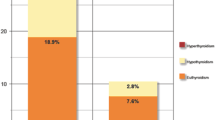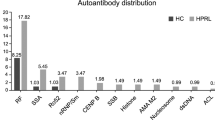Abstract
The interrelationship between prolactin (PRL) and the immune system have been elucitaded in the last decade, opening new important horizons in the field of the immunoendocrinology. PRL is secreted not only by anterior pituitary gland but also by many extrapituitary sites including the immune cells. The endocrine/paracrine PRL has been shown to stimulate the immune cells by binding to PRL receptors. Increased PRL levels, frequently described in autoimmune diseases, could depend on the enhancement of coordinated bi-directional communications between PRL and the immune system observed in these diseases. Hyperprolactinemia has been described in the active phase of some non organ-specific autoimmune diseases, as systemic lupus erythematosus (SLE) and rheumatoid arthritis (RA) and organ-specific autoimmune diseases, as celiac disease, type 1 diabetes mellitus, Addison's disease, autoimmune thyroid diseases. In these diseases PRL increases the syntesis of IFNγ and IL-2 by Th1 lymphocytes. Moreover, PRL activates Th2 lymphocytes with autoantibody production. Of particular interest is the association between hyperprolactinemia and levels of anti DNA antibodies, islet cell antibodies (ICA), thyreoglobulin antibodies (TgAb), thyroperoxidase antibodies (TPOAb), adrenocortical antibodies (ACA), transglutaminase antibodies (tTGAb) in SLE, in type 1 diabetes mellitus, in Hashimoto's thyroiditis, in Addison's disease and in celiac disease, respectively. High levels of PRL have been also frequently detected in patients with lymphocytic hypophysitis (LYH). Several mechanisms have been invoked to explain the hyperprolactinemia in LYH. The PRL increase could be secondary to the inflammatory process of the pituitary gland but, on the other hand, this increase could have a role in enhancing the activity of the immune process in LYH. Moreover, the detection of antipituitary antibodies targeting PRL-secreting cells in some patients with idiopathic hyperprolactinemia suggests the occurrence of a possible silent LYH in these patients. Finally, the role of anti-prolactinemic drugs to inactivate the immune process in LYH is still discussed.
Similar content being viewed by others
References
Ben-Jonathan N, Mershon JL, Allen DL, Steinmetz RW. Extrapituitary prolactin: distribution, regulation, functions, and clinical aspects. Endocr Rev 1996;17:639–669.
Chikanza IC. Prolactin and neuroimmunomodulation: in vitro and in vivo observations. Ann N Y Acad Sci 1999;876:119–130.
Kooijman R, Hooghe-Peters EL, Hooghe R. Prolactin, growth hormone, and insulin-like growth factor-I in the immune system. Adv Immunol 1996;63:377–454.
Matera L. Action of pituitary and lymphocyte prolactin. Neuroimmunomodulation 1997;4:171–180.
Bole-Feysot C, Goffin V, Edery M, Binart N, Kelly PA. Prolactin (PRL) and its receptor: actions, signal transduction pathways and phenotypes observed in PRL receptor knockout mice. Endocr Rev 1998;19:225–268.
Bazan JF. A novel family of growth factor receptors: A common binding domain in the growth hormone, prolactin, erythropoietin and IL-6 receptors, and the p75 IL-2 receptor beta-chain. Biochem Biophys Res Commun 1989;164:788–795.
Cosman D. The hematopoietin receptor superfamily. Cytokine 1993;5:95–106.
Matera L, Mori M, Geuna M, Buttiglieri S, Palestro G. Prolactin in autoimmunity and antitumor defence. J Neuroimmunol 2000;109:47–55.
Matera L, Contarini M, Bellone G, Forno B, Biglino A. Up-modulation of interferon-gamma mediates the enhancement of spontanous cytotoxicity in prolactin-activated natural killer cells. Immunology 1999;98(3):386–392.
Dorshkind K, Horseman ND. The roles of prolactin, growth hormone, insulin-like growth factor-I, and thyroid hormones in lymphocyte development and function: Insights from genetic models of hormone and hormone receptor deficiency. Endocr Rev 2000;21:292–312.
Vera-Lastra O, Jara LJ, Espinoza LR. Prolactin and autoimmunity. Autoimmun Rev 2002;1:360–364.
Brennan P, Hajeer A, Ong KR, Worthington J, John S, Thomson W, Silman A, Ollier B. Allelic markers close to prolactin are associated with HLA-DRB1 susceptibility alleles among women with rheumatoid arthritis and systemic lupus erythematosus. Arthritis Rheum 1997;40:1383–1386.
Stevens A, Ray D, Alansari A, Hajeer A, Thomson W, Donn R, Ollier WE, Worthington J, Davis JR. Characterization of a prolactin gene polymorphism and its associations with systemic lupus erythematosus. Arthritis Rheum 2001;44:2358–2366.
Besedovsky HO, del Rey A. Immune-neuro-endocrine interactions: facts and hypotheses. Endocr Rev 1996;17:64–102.
Chikanza IC, Grossman AB. Reciprocal interactions between the neuroendocrine and immune systems during inflammation. Rheum Dis Clin North Am 2000;26:693–711.
Chikanza IC. Prolactin and neuroimmunomodulation: in vitro and in vivo observations. Ann N Y Acad Sci 1999;876:119–123.
Jara LJ, Vera-Lastra O, Miranda JM, Alcala M, Alvarez-Nemegyei J. Prolactin in human systemic lupus erythematosus. Lupus 2001;10:748–756.
Chikanza IC, Petrou P, Chrousos G, Kingsley G, Panayi GS. Excessive and dysregulated secretion of prolactin in rheumatoid arthritis: immunopathogenetic and therapeutic implications. Br J Rheumatol 1993;32:445–448.
El Miedany YM, Ahmed I, Moustafa H, El Baddini M. Hyperprolactinemia in Sjogren's syndrome: a patient subset or a disease manifestation? Joint Bone Spine 2004;71:203–208.
Neidhart M. Prolactin in autoimmune diseases. Proc Soc Exp Biol Med 1998;217(4):408–419.
Li J, Teng W, Shan Z. Effects of prolactin on HLA-DR and CD40 expressions by human thyrocytes. Chin Med J 2001;114:1151–1156.
Giusti M, Foppiani L, Fazzuoli L, Molinari E, Guido R, Valenti S, Giordano G. An increased prevalence of thyroid echographic and autoimmune changes in hyperprolactinemic women on therapy with dopaminergic drugs. Recenti Prog Med 1999;90:147–151.
Lever EG, McKerron CG. Auto-immune Addison's disease associated with hyperprolactinaemia. Clin Endocrinol 1984;21:451–457.
Thodou E, Asa SL, Kontogeorgos G, Kovacs K, Horvath E, Ezzat S. Clinical case seminar: lymphocytic hypophysitis: clinicopathological findings. J Clin Endocrinol Metab 1995;80:2302–2311.
Kapur G, Patwari AK, Narayan S, Anand VK. Serum prolactin in celiac disease. J Trop Pediatr 2004;50:37–40.
Azar ST, Yamout B. Prolactin secretion is increased in patients with multiple sclerosis. Endocr Res 1999;25:207–214.
Duncan GS, Mittrucker HW, Kagi D, Matsuyama T, Mak TW. The transcription factor interferon regulatory factor-1 is essential for natural killer cell function in vivo. J Exp Med 1996;184:2043–2048.
Matera L, Mori M. Cooperation of pituitary hormone prolactin with interleukin-2 and interleukin-12 on production of interferon-gamma by natural killer and T cells. Ann N Y Acad Sci 2000;917:505–511.
Nagafuchi H, Suzuki N, Kaneko A, Asai T, Sakane T. Prolactin locally produced by synovium infiltrating T lymphocytes induces excessive synovial cell functions in patients with rheumatoid arthritis. J Rheumatol 1999;26:1890–1900.
Jacobi AM, Rohde W, Ventz M, Riemekasten G, Burmester GR, Hiepe F. Enhanced serum prolactin (PRL) in patients with systemic lupus erythematosus: PRL levels are related to the disease activity. Lupus 2001;10:554–561.
Walker SE, Allen SH, Hoffman RW, McMurray RW. Prolactin: a stimulator of disease activity in systemic lupus erythematosus. Lupus 1995;4:3–9.
Alvarez-Nemegyei J, Cobarrubias-Cobos A, Escalante-Triay F, Sosa-Munoz J, Miranda JM, Jara LJ. Bromocriptine in systemic lupus erythematosus: A double-blind, randomized, placebo-controlled study. Lupus 1998;7:414–419.
Jacobi AM, Rohde W, Volk HD, Dorner T, Burmester GR, Hiepe F. Prolactin enhances the in vitro production of IgG in peripheral blood mononuclear cells from patients with systemic lupus erythematosus but not from healthy controls. Ann Rheum Dis 2001;60:242–247.
Cruz J, Avina-Zubieta A, Martinez de la Escalera G, Clapp C, Lavalle C. Molecular heterogeneity of prolactin in the plasma of patients with systemic lupus erythematosus. Arthritis Rheum 2001;44:1331–1335.
De Schepper J, Schiettecatte J, Velkeniers B, Blumenfeld Z, Shteinberg M, Devroey P, Anckaert E, Smitz J, Verdood P, Hooghe R, Hooghe-Peters E. Clinical and biological characterization of macroprolactinemia with and without prolactin-IgG complexes. Eur J Endocrinol 2003;149:201–207.
Leanos A, Pascoe D, Fraga A, Blanco-Favela F. Anti-prolactin autoantibodies in systemic lupus erythematosus patients with associated hyperprolactinemia. Lupus 1998;7:398–403.
Leanos-Miranda A, Pascoe-Lira D, Chavez-Rueda KA, Blanco-Favela F. Persistence of macroprolactinemia due to antiprolactin autoantibody before, during, and after pregnancy in a woman with systemic lupus erythematosus. J Clin Endocrinol Metab 2001;86:2619–2624.
Ippoliti F, De Santis W, Volterrani A, Lenti L, Canitano N, Lucarelli S, Frediani T. Immunomodulation during sublingual therapy in allergic children. Pediatr Allergy Immunol 2003;14:216–221.
Hosokawa Y, Yang M, Kaneko S, Tanaka M, Nakashima K. Prolactin induces switching of T-cell receptor gene expression from alpha to gamma in rat Nb2 pre-T lymphoma cells. Biochem Biophys Res Commun 1996;220:958–962.
Zuany-Amorim C, Ruffie C, Haile S, Vargaftig BB, Pereira P, Pretolani M. Requirement for gammadelta T cells in allergic airway inflammation. Science 1998;280:1265–1267.
Cheung CC, Ezzat S, Smyth HS, Asa SL. The spectrum and significance of primary hypophysitis. J Clin Endocrinol Metab 2001;86:1048–1053.
Beressi N, Beressi JP, Cohen R, Modigliani E. Lymphocytic hypophysitis. A review of 145 cases. Ann Med Interne (Paris) 1999;150:327–341.
Abe T, Matsumoto K, Sanno N, Osamura Y. Lymphocytic hypophysitis: case report. Neurosurgery 1995;36:1016–1019.
Bellastella A, Bizzarro A, Coronella C, Bellastella G, Sinisi AA, De Bellis A. Lymphocytic hypophysitis: a rare or underestimated disease? Eur J Endocrinol 2003;149:363–376.
Caturegli P, Newschaffer C, Olivi A, Pomper MG, Burger PC, Rose NR. Autoimmune Hypophysitis. Endocr Rev 2005; 26:599–614.
De Bellis A, Bizzarro A, Conte M, Perrino S, Coronella C, Solimeno S, Sinisi AM, Stile LA, Pisano G, Bellastella A. Antipituitary antibodies in adults with apparently idiopathic growth hormone deficiency and in adults with autoimmune endocrine diseases. J Clin Endocrinol Metab 2003;88:650–654.
De Bellis A, Bizzarro A, Bellastella A. Pituitary antibodies and lymphocytic hypophysitis. Best Pract Res Clin Endocrinol Metab 2005;19:67–84.
Keda YM, Krjukova IV, Ilovaiskaia IA, Morozova MS, Fofanova OV, Babarina MB, Marova EI, Pankov YA, Kandror VI. Antibodies to pituitary surface antigens during various pituitary disease states. J Endocrinol 2002;175:417–423.
Amadori P, Dilberis C, Marcolla A, Pinamonti M, Menapace P, Valentini A. Identification of IgG-immunocomplex macroprolactin with an immunometric “sandwich” system: Technical and clinical considerations. J Endocrinol Invest 2004;27:1022–1028.
Bottazzo GF, Pouplard A, Florin-Christensen A, Doniach D. Autoantibodies to prolactin-secreting cells of human pituitary. Lancet 1975;2:97–101.
Bodey B, Bodey BJr, Kaiser HE. Dendritic type, accessory cells within the mammalian thymic microenvironment. Antigen presentation in the dendritic neuro-endocrine-immune cellular network. In Vivo 1997;11:351–370.
Horvath E, Kovacs K. Folliculo-stellate cells of the human pituitary: a type of adult stem cell? Ultrastruct Pathol 2002;26:219–228.
De Jersey J, Carmignac D, Barthlott T, Robinson I, Stockinger B. Activation of CD8 T cells by antigen expressed in the pituitary gland. J Immunol 2002;169:6753–6759.
De Jersey J, Carmignac D, Le Tissier P, Barthlott T, Robinson I, Stockinger B. Factors affecting the susceptibility of the mouse pituitary gland to CD8 T-cell-mediated autoimmunity. Immunology 2004;111:254–261.
Tashiro T, Sano T, Xu B, Wakatsuki S, Kagawa N, Nishioka H, Yamada S, Kovacs K. Spectrum of different types of hypophysitis: a clinicopathologic study of hypophysitis in 31 cases. Endocr Pathol 2002;13:183–195.
Author information
Authors and Affiliations
Corresponding author
Rights and permissions
About this article
Cite this article
De Bellis, A., Bizzarro, A., Pivonello, R. et al. Prolactin and Autoimmunity. Pituitary 8, 25–30 (2005). https://doi.org/10.1007/s11102-005-5082-5
Issue Date:
DOI: https://doi.org/10.1007/s11102-005-5082-5




